AAPL’s roots and the modern private lending industry can be traced to the Great Recession.
It is 2009, and the Great Recession is in full swing. The federal government has passed the Secure and Fair Enforcement for Mortgage Licensing (SAFE) Act and taken control of mortgage giants Fannie Mae and Freddie Mac. Foreclosures are at an all-time high. Bank bailouts are being approved right and left. And, Congress has just been presented with the initial version of what would become the Dodd-Frank Wall Street Reform and Consumer Protection Act. Risk is high, confidence is low, and only one thing is certain: Uncle Sam’s hammer is about to come down.
In summary, it is an inconvenient time to be in the lending industry.
The Origin Story
As banks trembled at early rumblings of sweeping regulatory reform and their mortgage lending practices came to a standstill, the glut of foreclosures on the market gave rise to a new wave of investors capitalizing on bottoming-out real estate prices—spurring a desperate need for capital.
Four investors saw the writing on the wall for institutional lenders and forecast the widening gap between borrower needs and banks’ ability and willingness to lend. Those four—Anthony Geraci of Geraci LLP, Jack Rollins of RCG LLC, and Wallace Groves and Tim Brickner of RBC Capital Markets—collectively committed $100,000 to create the National Hard Money Association.
Next, they considered ideas about how to move the industry into the mainstream and ensure its continued viability. With the SAFE Act’s passage, hard money lenders for the first time fell under federal regulators’ purview—and more pervasive legislation was in the offing.
A small group of hard money and service provider movers and shakers from across the U.S. huddled in a cramped meeting room at Caesars Palace Las Vegas.
First to the chopping block was the “hard money” terminology. The phrase no longer accurately defined the industry’s business practices, and its connotations were less than positive after the Wild West lending atmosphere that snowballed into the financial crisis.
Out of much discussion came a modern appellation for an ancient vocation: private lending.
A new, self-styled name in place, the intrepid group next sought to learn from institutional lenders’ hubris; namely, that the wings of private lenders would be clipped and their operational gap welded shut absent a degree of self-oversight and adherence to established best practices.
Identifying the need for structure was straightforward, but administering it was something else entirely. The group acknowledged that endemic to the profession is that what allows for the demand gap—limited regulation—also makes private lenders’ wholesale identification next to impossible.
The question became “How do we provide for the future needs of a trade that, by its very nature, is extremely decentralized?”
Today, the group’s participants cannot name who originally put forth the idea, but by the meeting’s end, all attendees named themselves as inaugural members of the first and only (and newly retitled) national association pledging to safeguard the private lending industry.
The American Association of Private Lenders (AAPL) was born.
Launching an Industry
From its small beginnings, but keeping pace with the aggressive expansion of the industry itself, AAPL has grown to become the oldest and largest trade association for private lenders. It has continued its history of private-lending industry firsts, some of which you may now recognize as trade standards:
National Conference // Each year since its debut, AAPL reconvenes at Caesars Palace Las Vegas to continue its mission of supporting best practices. From its humble beginnings, #AAPLANNUAL is today the largest national private lender gathering and continues to be the choice event among industry executives. The association also became the first to host a hybrid conference with both in-person and virtual attendance, continuing its goal toward increasing inclusiveness and accessibility.
Code of Ethics // AAPL expects its members to adhere to a code of conduct above the minimum standard established by law. This ensures not only that borrowers, investors, and partners can trust members as an extension of the association’s unrivaled reputation but also that the industry can point to the Code—and AAPL’s complaint process—as proof that its internal checks and balances are more than adequate. Today, AAPL remains the public’s only mainstream avenue to report private lender ethics violations.
Member Directory // AAPL’s member directory has gone through many iterations, but today it stands as the premier place for borrowers and investors to validate membership and find reputable partners. Visitors filter members by service area, business sector, loan type, and more. Members can create and update their own profiles with contact info, company description, images, and video.
Member Emblem // Throughout their marketing materials, members may use the association’s “Proud Member” insignia to publicize their standing. Importantly, AAPL traces the emblem’s usage to ensure only active members gain the benefit of affiliation.
Trade Magazine // Private Lender is the industry’s quarterly source for the latest market trends, executive interviews, and deep-dive exploration of operations and strategy—all targeted at a specifically private lender audience. Available to the public at no cost in both print and digital formats, the magazine serves as a way for all practitioners—whether members or not—to keep up with best practices.
Government Relations Committee // Since its inception, AAPL’s Government Relations Committee has had a 100% success rate in blocking the passage of legislation that would prove harmful to private lenders. The committee has defeated three business-purpose mortgage licensing bills in Florida, a 20% sales price tax on flips and later a commercial licensing bill in New York, a licensing proposal for self-serviced loans in Colorado, and a California bill that would have required mandatory COVID-19 foreclosure forbearance absent any proof of hardship.
Federally, the Securities and Exchange Commission (SEC) cited AAPL’s comments in support of the expansion of the accredited investor definition, and the Committee is beginning to see traction in its Day on Capitol Hill advocacy efforts. AAPL stands today as the only trade association advocating nationally on behalf of private lenders.
Trade Certifications // For members looking to demonstrate their knowledge and commitment, AAPL’s Certified Private Lender Associate (CPLA) and Certified Fund Manager (CFM) designations are the only private lender trade-specific credentials. Taught by subject-matter experts and active practitioners, CFM is currently available online, with CPLA to follow by the end of 2021. AAPL continues to expand on the coursework with in-person training at its annual conference and select partner events.
Industry Awards // While AAPL’s Excellence Awards model is now ubiquitous among private lender events, the honors program that recognizes a Rising Star, Service Provider and Lender Members of the Year, and Community Impact awardees is the gold standard for distinction among private lenders.
Quarterly Benchmark Survey // Open to any active private lending company, the quarterly survey is the first—and to date, only—mechanism of its kind to regularly poll practitioners on benchmark data like loan terms, foreclosure rates, and market-confidence assessments. Survey respondents receive an anonymized and aggregated insight report from the results, with AAPL using the data to support advocacy efforts and measure market change.
Online Education & Resource Portal // AAPL’s online dashboard gives members access to everything from downloadable checklists, templates, and guides to educational video archives, a vetted service provider directory, and compliance center. The dashboard also serves as a central location for AAPL programs through which members can gain industrywide recognition.
Background Checks // AAPL is the first private lender trade organization to offer company-level background checks—a process by which members can display a globally recognized verification badge on marketing materials and gain differentiation in the association’s member directory.
Continuing the Mission
Throughout this lengthy journey of firsts, AAPL has held true to its inaugural mission: providing for the industry’s dedication to best practices, instilling oversight processes, and fighting regulatory encroachment. This commitment has safeguarded the private lending profession’s exponential growth and advancement into mainstream acceptance, demonstrating that its practitioners are organized and trustworthy.
We are proud to be an industry trailblazer while maintaining a longstanding reputation for excellence, integrity, and inclusiveness. We look forward to many more years of supporting our members and the private lending profession.












I remember that first meeting very well. Seems like yesterday.